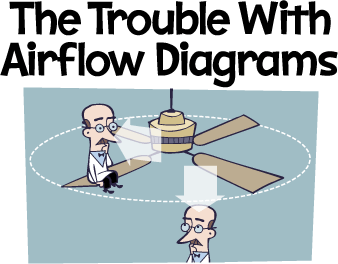

The airflow diagram commonly seen with many explanations of lift can be confusing because it’s the wing that moves through the air, not the other way around. Looking for lift this way is like trying to understand a ceiling fan while sitting on the blade as it spins around. Which will probably only make you dizzy. What you’ll feel is wind in your face, and you’ll see the room spinning around you. But if you stand underneath you’d see the fan go around and feel a downdraft on the top of your head.
Like the little man on the fan, a pilot travelling with the wing sees airflow, while a ground observer, like the little man under the fan, sees the wing moving. Your typical airflow diagram (below) shows air flowing around a wing. This is how it looks from the point of view of the wing which sees air moving around it. That is, if a wing could see and air were visible.
This is misleading because in this case the thrust is on the air rather than on the wing, which isn’t how planes usually do it. The air’s front to back movement is from thrust, the up and down movement is from the wing. Lift is from forcing air down, not back. That’s why they talk about lift coming from downwash and not backwash.
The second problem with typical airflow diagrams is they often show a narrow flow of air above and below. Yet the wing affects a lot more air than that, and a lot farther and for longer. The vortex extends well above, below, behind and in front of the wing.
You need to pull back to a wider angle to fit it all in. A better picture of airflow might be something like the following. (Note: These diagrams are rough approximations done just to make the point. Don’t take these to the bank.)
Then again, we have the same problem as in the first diagram. We have the thrust on the air moving it backward rather than on the wing moving it forward. Not only that, but the view from the wing would also show the ground, and an observer on the ground moving backwards with the air.
So, what we have is an air/ground/observer-flow diagram. Is this really the best way to view what’s going on, the ground, an observer on the ground and the air all flowing backward? How do you wrap your head around that?
Let’s look at it the way we actually look at it, the air, ground and observer in place and the wing moving. Here’s what we get.
Lastly, let’s isolate just one section of air above our little man to see what he sees the air there do. He doesn’t see air flowing back, he sees it going up a little as the wing approaches and then down. Hey, they don’t call it downwash for no good reason. Of course, it’s not as neat and orderly as shown, but that’s the rough idea of what happens, air goes mostly down and not back.
Just to add a little more which might interest, you can’t get lift without drag. Since everything starts with the wing going forward, the reaction is back, or drag. The angle of attack redirects most of the drag upwards, changing it to lift. Think of it this way, lift is upward drag.
Another way to get lift would be to flap the wings like a bird. This is not very practical for airplanes which are a lot bigger and heavier and don’t have feathers. But then, birds don’t have propellers or jet engines. Birds use wings both for lift and thrust. It’s a whole different animal, and planes aren’t animals at all.
© Terry Colon, 2016
Other bits from the flying files:
A Simple Way to See How Planes Fly
If you tuned in for our how planes fly bits, you might like our take on bicycles: